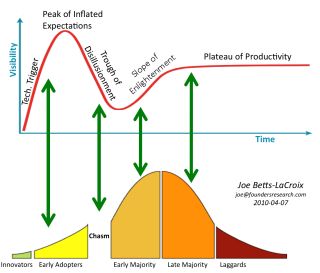Shortcuts Do Not Exist
Many of you are familiar with the “technology adoption life cycle” model, long a pillar of everything from new tech product pitches to IPO roadshows. However, overuse has eroded the model’s impact. Today, it’s less an effective visualization of market traction, and more a symbol of how distorted our tech industry’s blitzing and bandwagon-hopping is when it comes to emerging technologies. In its simplest form, the adoption bell curve illustrates how a new product will be progressively accepted over time across innovators, early adopters, early majority, late majority, and laggards. But today’s conversations about technologies often focus only on the stories of the most eager, cutting-edge innovators—ignoring 95 percent of the rest of the story; that is, the years (if not decades) that technology takes to reach mainstream adoption. InfoWorld August 13, 2018, Shortcuts to serverless adoption don’t exist.
I was blown away. It was a class given by Dr. John Maher at the Software Engineering Institute. It was about managing change in an organization and other concepts such as the technology adoption curve of an organization. I had discovered that all my frustrations with getting people to do things differently, to improve, was actually all normal. My railing at the intransigence of people was now replaced instead with observing how people, teams, and organizations slowly went through resistance and then finally acceptance of a new idea or way of doing business.
I could now literally plan based on knowing that I would get initial and often vigorous resistance to the change followed by some early adopters and then eventually ending up becoming the way we did business. Now, this was for a successful effort. A lot of efforts still failed because we never got beyond the resisters or that they snuffed out the early adopters. These were almost always organizations that ultimately crashed and failed in their industry and were generally sold off at fire sale prices.
See more on rapid change takes time and on the adoption curve.
Nevertheless, knowing the typical adoption curve an organization will go through makes it almost easy to patiently endure the inevitable initial resistance and slow uneven adoption. Just realizing that “this is normal” and that knowing how adoption will generally play out noticeably reduced my anxiety level as I managed challenging projects.
See knowing what is normal.
Do you understand adoption life cycles and have you included their impact in your project planning?
